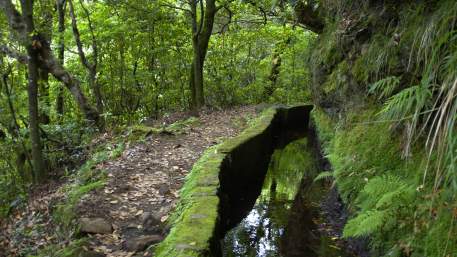
Find other trails from your selection here
Levada do Furado
Levadas e Veredas
Starting in Ribeiro Frio in the municipality of Santana this levada follows the Levada da Serra do Faial or Levada do Furado walkway till the water station. Here you will find a path descending in the direction of the village of Lamaceiros, ending at Portela's belvedere located in the municipality of Machico. The route followed by the Levada do Furado is evidence of the ward work that went into the opening of these irrigational channels to carry water from their sources on the northern coast to the terraces located in the southern coast. Along this levada you can see several rocky formations and shades of green from the island's nativo forest- the Laurissilva- characterized by predominantly laurel trees, or bay trees (Laurus novocanariensis), the lily-of-the-valley tree (Clethra arborea), the Madeira Laurel (Ocotea foetens), Madeira mahogany (Persea indica), as well as the yellow, or Madeira foxglove (Isoplexis sceptrum), the Pride of Madeira (echium condicans), Mandon's Chrysanthemum (Argyranthemum pinnatifidum), and the Madeiran orchid (Dactylarhiza foliosa). One may see the Firecrest (Regulus ignicapillus madeirensis), the smallest bird residing in Madeira, and the intrepid Chaffinch (Fringila coelebs). Less likely to be seen in the Madeira long-toed pigeon (columba trocaz trocaz), a species endemic to Madeira. It is at Lamaceiros that the waters are separated and here ends the along this levada you can see several rocky. Crossing the forested area of Lamaceiros and passing the Forestry Station of Lamaceiros, the trail follows a dirt road until it meets the Levada da Portela, which goes around the left side of Lombo das Faias, coming to an end where it meets the Regional Road ER102.
Types

Your opinion is important. Please rate your experience.
Programmes
View MoreClose
Search results for:
No results were found matching your search. We suggest changing the filters used.





